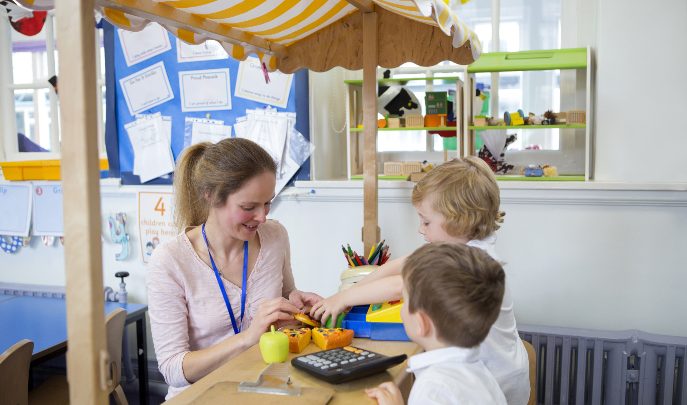Interact With Play From A Child’s Perspective – Uninhibited, Imaginatively And Enthusiastically

How you set up your classroom and interact with children as they follow their interests has a huge impact on the quality of learning that will take place

For early years practitioners, particularly those new to their role, ensuring that a play-based curriculum delivers tangible learning outcomes is high on the list of priorities. Seasoned professionals will be familiar with battling the outdated perception of children in their setting merely ‘playing all day’, whilst the ‘real learning’ takes place elsewhere.
We all aspire to the perfect balance of child-initiated play and timely adult support; to a setting that feels alive with the rich dialogue of constructive and meaningful play. But how is child-led play interacted with most skilfully? And what can we do to ensure that our environments offer the most constructive and developmentally relevant play opportunities?
Use words wisely
What have you built? How many blocks have you used? We’re all familiar with some of the borderline clichés that are used as an attempt to interact with young children whilst they play.
Though well-meaning, these type of questions are undoubtedly problematic. They often result in unenthusiastic one-word responses, or, worse, result in halting the momentum of play entirely.
Remember, play is a direct route to a child’s creativity and imagination, and employing more open-ended questioning – eg “What does it remind you of?” or “What could we do to make the car fit?” – allows for much more elaborate and insightful responses.
Moreover, as many experienced practitioners know to be true, sometimes no questioning at all is the best course of action. Simply listening and, at times, recording children’s adult-free dialogue during play offers a wealth of insight into their creative world.
Often, removing the element of adult pressure from the scenario allows children to interact more readily with their peers about their intentions and ideas. Herein lies true evidence of their understanding and thoughts.
What’s on offer?
Space constraints. Budgeting issues. Adult ratios. It’s a rare setting that isn’t hindered by these factors. There are though, thankfully, simple audits we can undertake to ensure that we are offering the best provision, within these limitations.
Think carefully about the location of your resources – are they accessible to the children themselves, displayed at their eye level? Are your resource labels made using photographs or do they require reading?
Allowing children to choose and access provision encourages decision-making and inquiry. It is wise to keep resources that can be most effectively combined during play in close proximity; being overly keen to keep resources in their designated areas can inhibit imaginative play and make some children more static in their choices.
Lastly, ensuring that your resources encompass a wide range of natural and man-made materials can expose the children in your setting to new learning opportunities. A huge amount of the resources they encounter daily are made of plastic, and these should be balanced alongside authentic natural and seasonal resources such as flowers, pinecones or driftwood.
Go with the flow
We’ve all witnessed the magical effect that child-led play can have on even the most seemingly disengaged of children. When children are allowed to follow their passions, their concentration span and focus visibly increases.
As an adult in the setting, one of our many challenges is to create a timetable or daily structure whereby the magic of play is not being constantly disrupted by administrative tasks, carpet time or adult input. Finding a balance between these priorities can be tricky, but taking a flexible approach and learning to ‘read the room’ is a valuable skill to hone.
Remember that free play is where authentic peer relationships are formed – if the children are demonstrating a relaxed but busy attitude towards their tasks, enjoying being ‘in the moment’ with their peers, then very little else is truly worthy of interruption.
Show, not tell
During play, particularly where very young children are concerned, experience is everything. Children need to touch, feel and use in order to make sense of the things on offer.
Every practitioner recognises the frustration of tirelessly creating a new, seemingly exciting, area of provision, only to see the children use it in a totally unintended way, or overlook it entirely.
Whilst it is important not to be too rigid in your expectations of play, it is helpful to model new resources to the children, and to physically demonstrate some relevant play.
Role play, for example, is one area where adult expectations are often ambitious. Expecting children to act out a fantasy or imaginative role, such as woodland creatures, or knights, is rarely realistic without some initial, meaningful, adult scaffolding.
The skilful act in such a context is to be yourself centred in the play, experiencing it alongside the children as you demonstrate. They will learn far more from watching how you play than from hearing your instructions.
Final thoughts
Getting play right in early years settings can seem like a never-ending challenge. Ensuring an effective breadth of provision alongside a balance of effective adult interactions is no easy task.
Once we value play as the cornerstone of the early childhood experience, we are able to think increasingly reflectively about what we, as adults, can offer to maximise each child’s experience. Bringing a flexible approach to your setting, knowing when to stand back and let play happen and regularly assessing the variety and location of resources on offer can all contribute to more effective play.
After all, there is very little more rewarding than witnessing children absorbed in the magic of play, building lasting friendships and learning through experience.
IN PRACTICE
Six ways to make the most of play…
• Link your resources to the natural world and the changing seasons to encourage understanding of the world around us.
• Work with colleagues to evaluate the questioning used in your setting – make each prompt open-ended, allowing the child to lead the way.
• Ensure play resources are accessible to the children, at a suitable height and clearly organised in order to promote the children’s independence of play. • Don’t be afraid to stand back – setting up your environment in a way that allows the children to thrive independently is something to aspire to. Their interactions don’t need an adult to make them meaningful.
• Be flexible in your approach to resources being moved around the setting to facilitate play; allowing children to combine materials often brings fantastically creative results!
• Channel your inner child – when interacting with play, do so from a child’s perspective, uninhibited, imaginatively and enthusiastically.
Claire Farman is EYFS Coordinator at Nottingham High School.











